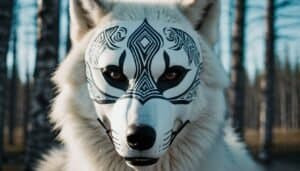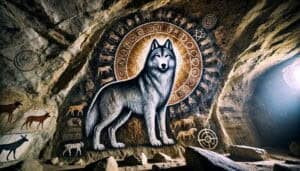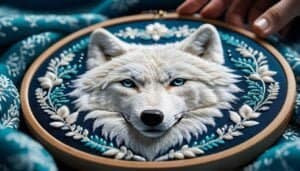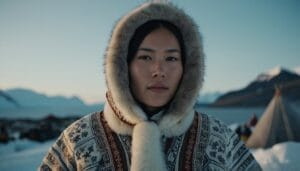Introduction
Arctic wolves hold a prominent place in the storytelling traditions of the Arctic regions, reflecting the deep connection between the wildlife and the indigenous cultures
This article delves into the multifaceted role of Arctic wolves in folklore, exploring their symbolic meanings, the themes they embody, and the legends that feature them. We will examine the impact of these majestic creatures on oral traditions, how they are represented in modern storytelling, and the educational value their stories provide
The Role of Arctic Wolves in Arctic Folklore
Arctic wolves have been an integral part of Arctic folklore for centuries, deeply intertwined with the cultural and spiritual lives of the indigenous peoples of the region
These majestic creatures are more than just animals in the harsh Arctic environment; they are symbols, messengers, and characters that carry profound meanings and lessons within the stories told by generations
Historical Significance of Wolves in Arctic Cultures
The historical significance of Arctic wolves in the folklore of the Arctic regions cannot be overstated. For indigenous communities such as the Inuit, the wolves are seen as fellow inhabitants of the land, sharing the same environment and struggles
This shared existence has led to a deep respect and admiration for the wolves, reflected in numerous stories and legends. Historically, wolves have been depicted as both companions and adversaries, embodying the dual nature of survival in the Arctic—both cooperative and competitive
Arctic wolves are often portrayed as guides and protectors in these tales. For example, in some Inuit legends, wolves are believed to lead lost hunters back to their villages, acting as guardians of the wilderness. This protective role highlights the wolves’ perceived wisdom and their ability to navigate the treacherous landscape, qualities that are highly valued in the Arctic cultures
Symbolic Meanings Attributed to Arctic Wolves
Arctic wolves carry a variety of symbolic meanings in Arctic folklore. They are often seen as embodiments of strength, endurance, and survival, reflecting the harsh realities of life in the Arctic. The wolf’s ability to endure extreme cold, hunt skillfully, and live in packs mirrors the communal and resilient nature of the indigenous peoples’ way of life
Wolves also symbolize freedom and independence, qualities that are admired and aspired to within these communities. The lone wolf, a recurring figure in many stories, represents the idea of self-reliance and the strength to face challenges alone, an important theme given the isolated and demanding environment of the Arctic
Moreover, wolves are sometimes viewed as spiritual beings with connections to the supernatural world. In certain tales, wolves are seen as messengers between the physical and spiritual realms, conveying messages from ancestors or spirits. This spiritual dimension adds a layer of reverence and mysticism to the wolves’ presence in folklore
Common Themes in Wolf Stories
Several common themes emerge in Arctic wolf stories, each reflecting different aspects of life and belief in the Arctic regions
One prevalent theme is the relationship between humans and nature. Many stories emphasize the interconnectedness of all living beings and the importance of living in harmony with the environment. Wolves often serve as reminders of this delicate balance, embodying both the beauty and danger of the natural world
Another common theme is transformation and adaptability. Stories often feature wolves that transform into humans or vice versa, symbolizing the fluid boundaries between human and animal realms. These transformations highlight the adaptability required to survive in the Arctic and the belief that humans can learn from animals’ resilience and instincts
Stories also frequently address the theme of respect and reverence for the animal kingdom. Wolves are depicted as noble creatures deserving of respect, and tales often convey moral lessons about the consequences of mistreating animals or disrupting the natural order. This theme underscores the ethical and spiritual values held by Arctic communities regarding their relationship with wildlife
The teaching of practical survival skills is another important theme. Wolf stories are used to impart knowledge about hunting techniques, navigation, and the social dynamics of living in close-knit communities. By embedding practical lessons within engaging narratives, these stories serve as both entertainment and education, ensuring the transmission of essential skills across generations
Popular Arctic Wolf Legends and Their Origins
Arctic wolf legends are rich with narrative depth and cultural significance, showcasing the profound connection between these majestic creatures and the indigenous peoples of the Arctic
These stories, passed down through generations, offer a glimpse into the values, beliefs, and experiences of Arctic communities. Here, we explore some of the most notable Arctic wolf legends and their origins, revealing how these tales have shaped and been shaped by the cultures that tell them
Notable Wolf Legends from Different Arctic Regions
One of the most famous Arctic wolf legends comes from the Inuit of Greenland, known as “Amarok.” In this legend, Amarok is a giant wolf that hunts alone and is often seen as a symbol of solitary strength and mystery
Unlike typical wolves that hunt in packs, Amarok’s solitary nature sets it apart, making it a powerful and somewhat ominous figure in Inuit mythology. The story often serves as a cautionary tale, warning hunters of the dangers of venturing into the wilderness alone and unprepared
Another well-known legend is that of the “Wolf Mother” among the Chukchi people of Siberia. This tale tells of a wolf that raises an abandoned human child, teaching the child the ways of survival in the harsh Arctic environment. The Wolf Mother legend underscores themes of compassion, adaptability, and the interconnectedness of all living beings. It also reflects the Chukchi’s respect for the wolf as a teacher and guide in the natural world
In Alaska, the legend of the “Spirit Wolf” is prevalent among the Tlingit people. According to this legend, the Spirit Wolf is a protector of the land and its people, possessing supernatural powers that allow it to communicate with the ancestors and the spirits of the land
The Spirit Wolf is often called upon in times of trouble to provide guidance and protection, symbolizing the Tlingit’s belief in the spiritual interconnectedness of all things
Influences of Wolves on Local Myths
Arctic wolves have significantly influenced local myths across the Arctic regions, often serving as central figures in stories that explain natural phenomena, cultural practices, and moral lessons. These myths frequently incorporate the characteristics and behaviors of wolves, using them to convey deeper truths and teachings
For example, in many Inuit myths, the behavior of the wolf pack is used to illustrate the importance of community and cooperation. Stories about wolves hunting together to take down larger prey are paralleled with human cooperation in hunting and survival, emphasizing the value of working together for the common good
This use of wolf behavior as a metaphor helps to reinforce social cohesion and mutual support within the community
In addition, the transformation myths common in Arctic folklore often feature wolves. These stories, in which humans transform into wolves or vice versa, explore themes of identity, belonging, and the fluid boundaries between the human and animal worlds
These transformations highlight the adaptability and resilience required to thrive in the Arctic environment, encouraging individuals to embrace these qualities
Evolution of Wolf Tales Over Time
Wolf tales in the Arctic have evolved over time, reflecting changes in the environment, social structures, and interactions with other cultures
As indigenous communities faced new challenges and opportunities, their stories adapted to incorporate these experiences, ensuring that the legends remained relevant and meaningful
In the past, wolf stories were primarily oral traditions, passed down through storytelling during communal gatherings. These stories were often tailored to the audience, with elders modifying details to emphasize particular lessons or address current issues
As Arctic communities began to interact more with Western cultures, some wolf legends were documented in written form, preserving them for future generations and allowing for a broader dissemination of these rich cultural narratives
The advent of modern media has also influenced the evolution of Arctic wolf tales. Stories that were once confined to the oral tradition are now being shared through books, films, and digital media, reaching a global audience. This broader exposure has led to a renewed interest in Arctic folklore and an appreciation for the cultural significance of wolf legends
However, this evolution has also brought challenges, as some traditional elements of the stories may be lost or altered in translation. Efforts to preserve and accurately convey these tales are crucial to maintaining the integrity and authenticity of the cultural heritage they represent
The Impact of Arctic Wolves on Oral Traditions
Arctic wolves have a profound impact on the oral traditions of indigenous Arctic communities. These narratives serve not only as entertainment but also as a means of preserving history, imparting wisdom, and reinforcing cultural values. The stories featuring Arctic wolves are deeply embedded in the oral traditions of the region, playing a crucial role in the cultural and social fabric of these communities
Storytelling Practices Involving Wolves
Storytelling in Arctic cultures is a communal activity, often conducted around a fire or during gatherings, where elders recount tales to the younger generation
Arctic wolves are frequent protagonists in these stories, symbolizing various traits and teaching important life lessons. These storytelling practices are designed to engage listeners, stimulate their imagination, and provide moral guidance
Wolves are often depicted as wise and powerful animals, embodying traits such as strength, cunning, and loyalty. Stories involving wolves might describe their hunting strategies, social structures, or interactions with humans. These tales not only entertain but also educate listeners about the natural world and the behaviors of animals within it
For instance, a common storytelling practice involves tales of wolf packs hunting together, which underscores the importance of cooperation and teamwork. These stories highlight the value of working together to achieve common goals, a lesson that is vital for survival in the harsh Arctic environment. By using wolves as characters, storytellers can impart these lessons in a relatable and memorable way
Transmission of Wolf Tales Through Generations
The transmission of wolf tales from one generation to the next is a vital aspect of Arctic oral traditions. Elders play a central role in this process, serving as the keepers of cultural knowledge and storytellers. They ensure that the stories remain relevant and are passed down accurately, preserving the cultural heritage of the community
Wolf stories are often introduced to children at a young age, serving as a tool for education and moral development
These tales teach children about the values and norms of their society, as well as practical knowledge about their environment. For example, stories about the hunting techniques of wolves might be used to teach children about the skills needed for hunting and survival
As children grow older, they are encouraged to participate in storytelling, gradually taking on the role of the storyteller themselves. This practice helps to reinforce the stories in their memory and ensures that the oral traditions are maintained. The interactive nature of storytelling allows for the adaptation and evolution of tales, ensuring that they remain relevant to each generation
The Role of Elders in Preserving Wolf Narratives
Elders hold a revered position in Arctic communities, acting as the custodians of cultural knowledge and traditions. Their role in preserving and transmitting wolf narratives is crucial for maintaining the continuity of these oral traditions. Elders are respected for their wisdom and experience, and their stories are considered an essential part of the community’s cultural heritage
Elders often possess a deep understanding of the symbolic meanings and lessons embedded in wolf stories. They use these tales to teach younger generations about the values and beliefs of their culture, as well as to provide guidance and advice. The stories told by elders are not static; they may adapt and change to address contemporary issues or to highlight particular lessons
The storytelling sessions led by elders are communal events, bringing the community together and reinforcing social bonds. These gatherings provide an opportunity for younger members to learn from the elders and for the community to celebrate its shared cultural heritage. The stories of Arctic wolves, told and retold over generations, serve as a bridge between the past and the present, ensuring that the cultural identity of the community is preserved
Arctic Wolves in Modern Storytelling
Arctic wolves continue to play a significant role in modern storytelling, adapting to contemporary contexts while retaining their symbolic and cultural importance. Through literature, media, and various artistic expressions, these majestic creatures remain embedded in the cultural narratives of the Arctic and beyond
Contemporary Stories Featuring Arctic Wolves
In contemporary storytelling, Arctic wolves are often depicted as symbols of wilderness and resilience
Modern stories continue to draw on the rich folklore traditions, adapting them to address current issues such as climate change, wildlife conservation, and cultural preservation. These stories are told through various mediums, including books, films, and digital media
For example, children’s literature frequently features Arctic wolves to teach lessons about the environment, teamwork, and survival. Books like “Julie of the Wolves” by Jean Craighead George explore the relationship between humans and wolves, highlighting the mutual respect and understanding necessary for coexistence. These stories not only entertain young readers but also educate them about the importance of wildlife and the challenges faced by Arctic ecosystems
In film and television, Arctic wolves often serve as symbols of the untamed natural world. Documentaries and nature programs showcase the lives of these animals, providing insight into their behaviors and habitats. Movies set in the Arctic, such as “The Journey of Natty Gann,” use wolves to underscore themes of adventure and survival, drawing on the wolves’ mythic qualities to enhance the narrative
Arctic Wolves in Literature and Media
Arctic wolves have a prominent place in both traditional and contemporary literature. Indigenous authors continue to incorporate wolf legends into their writings, preserving the cultural narratives while introducing them to new audiences. These works often blend traditional storytelling techniques with modern literary styles, creating a rich tapestry of cultural expression
In addition to indigenous literature, Arctic wolves appear in a wide range of genres, from fantasy to science fiction
Authors use these animals to symbolize various themes, such as freedom, wilderness, and the struggle for survival. In fantasy novels, wolves often serve as companions to heroes, embodying loyalty and strength. In science fiction, they may represent the untamed aspects of nature in a futuristic or dystopian world
Media representation of Arctic wolves has also evolved with the advent of new technologies. Virtual reality (VR) and augmented reality (AR) experiences allow users to interact with lifelike representations of wolves, providing immersive educational and entertainment opportunities. These technologies bring the stories of Arctic wolves to a global audience, fostering a greater appreciation for these animals and their cultural significance
Ongoing Cultural Significance of Wolves
Despite the changes brought by modernization, Arctic wolves retain their cultural significance among indigenous communities. They continue to be featured in cultural events, artistic expressions, and educational programs, serving as a reminder of the deep connection between humans and the natural world
Cultural festivals and gatherings often include performances and exhibitions that celebrate the role of wolves in Arctic folklore. Traditional dances, music, and storytelling sessions highlight the enduring presence of wolves in the cultural landscape. These events not only preserve cultural heritage but also strengthen community bonds and promote cultural pride
Artistic expressions, such as painting, sculpture, and crafts, frequently depict Arctic wolves, capturing their beauty and power
Indigenous artists use traditional and contemporary techniques to create works that reflect their cultural identity and the significance of wolves in their worldview. These artworks are displayed in galleries, museums, and cultural centers, providing a visual representation of the stories and symbols associated with Arctic wolves
Educational programs in schools and community centers often include lessons about the cultural and ecological importance of wolves. These programs aim to foster a sense of respect and responsibility towards wildlife and the environment. By learning about the role of wolves in their cultural heritage, young people gain a deeper understanding of their identity and the interconnectedness of all living beings
Teaching and Learning through Arctic Wolf Stories
Arctic wolf stories serve as a powerful educational tool in Arctic communities, imparting valuable knowledge and cultural values to younger generations. These narratives are a vital part of the oral traditions, used to teach lessons about survival, community, and the natural world
Educational Value of Wolf Narratives
Arctic wolf stories are rich with educational value, providing lessons on a wide range of topics. For example, these stories often incorporate practical survival skills essential for life in the Arctic
They teach listeners about hunting techniques, tracking, navigation, and understanding animal behavior. By embedding these lessons within engaging narratives, elders ensure that important knowledge is passed down in a memorable and impactful way
Moreover, wolf stories are used to teach moral and ethical values. They often contain themes of cooperation, respect for nature, bravery, and resilience. For instance, tales of wolves hunting in packs emphasize the importance of working together and supporting one another, a lesson that is vital for the survival of both wolves and humans in the harsh Arctic environment. Through these narratives, children learn the values that are central to their culture and way of life
Role of Stories in Child Development
Wolf stories play a significant role in the development of children in Arctic communities. From a young age, children are exposed to these tales, which stimulate their imagination and help them understand the world around them. The characters and adventures in wolf stories capture their interest and curiosity, making the learning process enjoyable and effective
These stories also help in developing important cognitive and social skills. Listening to and recounting wolf tales improves children’s language abilities, memory, and comprehension
They learn to listen attentively, remember details, and understand complex narratives. Additionally, participating in storytelling sessions enhances their social skills, as they engage with family and community members in a shared cultural practice
Arctic wolf stories also foster a deep connection to their cultural heritage. By hearing these tales, children gain a sense of identity and belonging. They learn about the history, traditions, and values of their people, which strengthens their cultural pride and continuity. This connection to their heritage is crucial for their overall development and well-being
Seasonal Influences on Storytelling
The seasonal changes in the Arctic have a significant impact on storytelling practices, including those involving Arctic wolves. The long winter nights, with their extended darkness, provide the perfect setting for storytelling
Families and communities gather around the warmth of a fire to share stories, passing the time and strengthening social bonds. During these gatherings, wolf stories are a favorite, as they reflect the challenges and beauty of the Arctic environment
In contrast, the summer months, with their continuous daylight, bring different storytelling opportunities. Outdoor gatherings and communal activities often include storytelling sessions, where wolf tales are recounted to entertain and educate. These stories might be told during hunting trips, teaching young hunters about the behaviors and habits of wolves and other animals they might encounter
The seasonal rhythms of the Arctic life are mirrored in the themes and content of the stories. Winter stories might focus more on survival, endurance, and the mystical aspects of the wolves, aligning with the harsh conditions and the sense of introspection that comes with the long nights
Summer stories, on the other hand, might emphasize adventure, exploration, and the dynamic relationships within the wolf pack, reflecting the more active and communal life of the summer months
Conclusion
Arctic wolves hold a pivotal role in the cultural and storytelling traditions of Arctic communities. From their historical significance in folklore to their symbolic meanings and the themes they represent, these majestic creatures are woven into the very fabric of Arctic life
Popular legends like Amarok and the Spirit Wolf illustrate the deep respect and reverence these animals command, while contemporary stories and media continue to showcase their enduring cultural impact
The rich oral traditions of the Arctic, sustained by elders and passed through generations, ensure that wolf tales remain a vital educational tool. These stories teach essential survival skills, moral values, and foster a deep connection to cultural heritage. Modern storytelling, whether through literature, film, or digital media, adapts these timeless narratives to new contexts, preserving their relevance and significance
Ultimately, Arctic wolf stories reflect the resilience, adaptability, and communal spirit of the Arctic peoples. They serve as a testament to the enduring bond between humans and the natural world, highlighting the lessons we can learn from these remarkable animals. Through these narratives, the legacy of the Arctic wolf continues to inspire and educate, ensuring that the cultural heritage of the Arctic remains vibrant and alive











